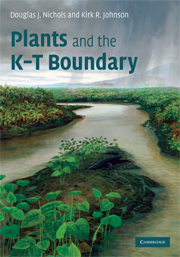7 - Other North American records
Published online by Cambridge University Press: 22 August 2009
Summary
Overview
In this chapter, we discuss some of the other well-documented K–T boundary localities in North America outside of the Williston Basin. These localities are situated in other sedimentary basins in a south-to-north corridor from New Mexico to Alaska, including parts of western Canada (Figure 7.1). Collectively these localities contribute to a large database of information about plants and the K–T boundary, although it will became clear to the reader that the quality of the records varies from one to the next. The south-to-north geographic distribution of these basins constitutes a proximal-to-distal array with respect to the postulated K–T impact crater on the Yucatan Peninsula of Mexico. This fact appears to have particular relevance with respect to preservation of a boundary claystone layer and other indicators of the K–T boundary discussed in Section 2.3, such as shocked minerals.
Raton Basin, Colorado and New Mexico
The first iridium-bearing terrestrial K–T boundary sections were discovered in the Raton Basin of southeastern Colorado and northeastern New Mexico (Figure 7.2). The K–T boundary is preserved in the Raton Formation, an entirely nonmarine unit of Maastrichtian and early Paleocene age (Figure 7.3). The Raton Formation is composed of sandstone, siltstone, mudstone, coal, and minor conglomerate. Thin to thick coal beds are common in the lower and upper parts of the formation, but are scarce to absent in the middle “barren series,” which is composed largely of sandstone.
- Type
- Chapter
- Information
- Plants and the K-T Boundary , pp. 104 - 158Publisher: Cambridge University PressPrint publication year: 2008



